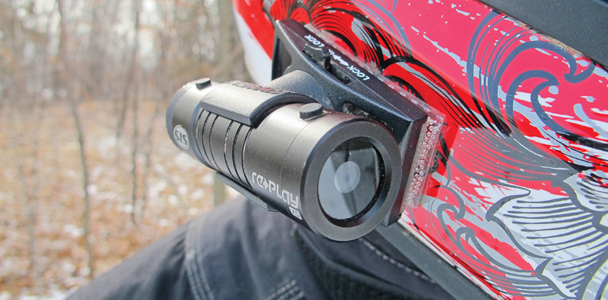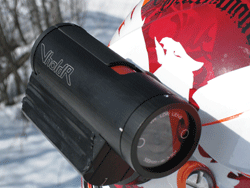
With the flexibility of video technology increasing, plus the hardware’s relative low cost along with easy accessibility to outlets on the Internet, anyone can get their 15 minutes of fame these days – or at least show their friends how much fun they had while snowmobiling.
I recorded hours of high-quality footage while riding new sleds, exploring fun destinations and testing aftermarket products with Twenty20’s VholdR camcorder last winter. The small, lightweight video camera was easy to use, and its self-contained, compact design was sleek so it sliced through the air and proved rugged and durable.
Several features prove that designers of the VholdR are smart and they understand their customers’ needs. A “beep” to indicate the camera is powered up, has started recording or has stopped recording was audible even while my snowmobile was moving down the trail. A leash – made from slight-but-strong, string-like material – is a smart feature that connects the camera to the mount plate so it won’t fall into the snow in case the camera becomes dislodged. This happened once when a branch whacked my head, but the camera stayed connected to my helmet.
Positioning the camera on my helmet took a few tries before I had it aimed correctly. The camera shoots two, red alignment lasers at startup, but they weren’t a practical setup method for snowmobile use, so I set it through trial and error. Footage of my first ride with the camera was mainly of the sled’s hood and side panel because I had the camera pointed too low. I adjusted the camera upward a few notches, but that was too high. By my third try, the camera was aimed correctly to show the nose of the sled for context while providing a good view of the terrain in front of me.
Software is loaded on the 1 mega-byte MicroSD card that came with the camera; installation of software on my PC was quick and easy. Working in the VholdR Desktop, I could import, clip and watch videos, and then publish them to the VholdR website. I’ve also saved files to my hard drive so I can edit them, add music and post them on other sites like YouTube. The VholdR Desktop software doesn’t have those capabilities.
Video quality is superb. Colors are true, light levels are good and all of the footage was steady, thanks to the sturdy mount plate. But since the VholdR has been phased out and replaced by the high-definition Contour HD ($299.99) and the Contour HD 1080p ($329.99), resolution should be even better on these new models.
Distortion from wind makes the audio poor when footage is of the sled moving more than a few miles per hour. The owner’s manual says placing a piece of tape over the microphone will reduce this effect, but the manual doesn’t say where the microphone is. I took a stab at its location and put a piece of electrical tape on the side, but that wasn’t right. Other than that oversight the manual was thorough, accurate and clear. Fortunately the microphone works well to record trailside conversations.
My testing showed that the card holds about 80 minutes of footage. I used the camera on many rides, recording clips that ranged from 30 seconds to about 15 minutes, but I never filled the card during a ride and the battery lasted all day, as long as I started with a fully charged pack. If you need snowmobile video footage to prove to the world that you’re worthy of celebrity status – or you just want to re-live fantastic memories – Twenty20 makes a great, easy way to do it.


